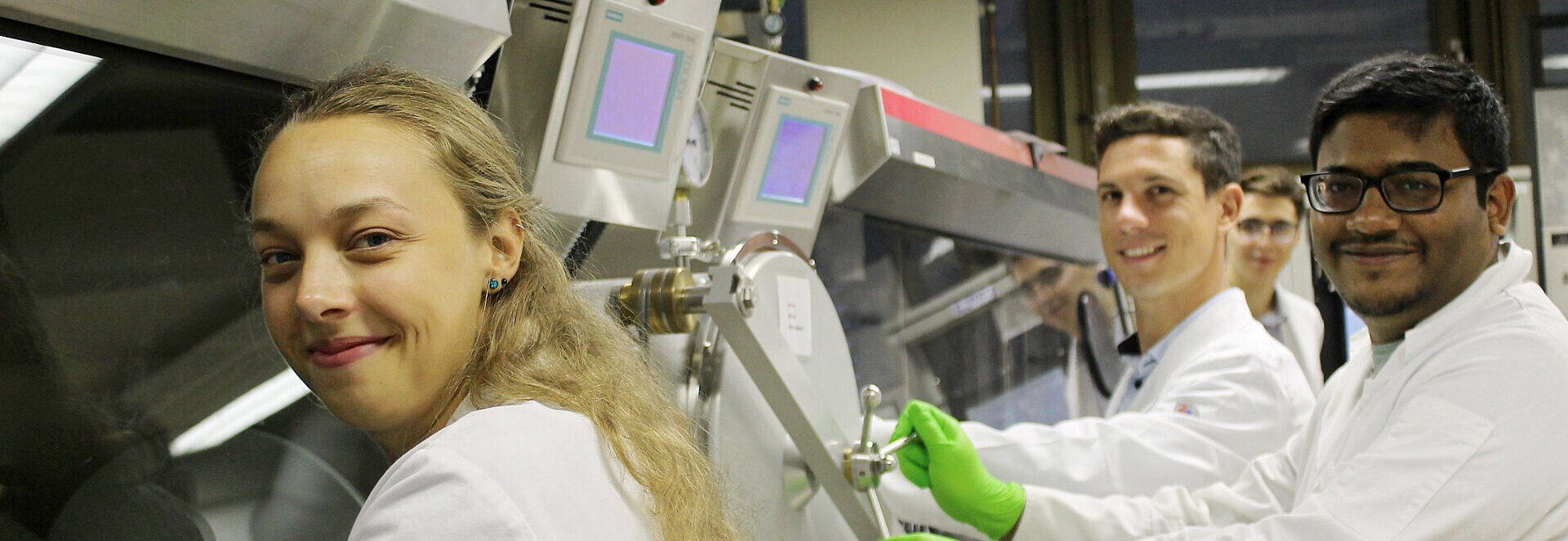Longer Lasting and More Efficient
Organic light emitting diodes (OLEDs) are the central component in the displays of today’s mobile phones, curved TVs, and medical displays. OLEDs have introduced such innovations as foldable or “wrap-around” displays and ultrahigh resolution 4K. They have expanded colour gamut and made high dynamic range (HDR) displays possible. But for blue light emission, all these displays still use fluorescent emitters, which are 75% less efficient than phosphorescent emitters.
Despite 10 years of research, there are no blue emitters that combine efficient phosphorescence with a long lifetime in an OLEDs in a way that meets commercial performance targets. But long lifetime and low energy consumption are key to sustainable technologies in Europe.


TADFlife Innovative Training Network
Aware of the stiff competition from the Far East, the EU has realized that such progress can only be achieved by combining expertise from universities and industry, from theory and experimentation. Meeting this challenge requires not only a framework of long-term partnerships and high-end research infrastructure, but also young, creative talent that is willing and able to drive scientific innovations.
Under the leadership of the University of Bayreuth, the TADFlife Marie-Skłodowska-Curie Innovative Training Network (ITN) has taken on this formidable task. The network is funded by the EU program Horizon 2020. “TADFlife is an exciting setup,” says Professor Anna Köhler, holder of the Chair of Soft Matter Optoelectronics at the University of Bayreuth. She heads the ITN, which comprises an international team of eight European universities, including Bayreuth and Augsburg, seven non-European universities, and six companies.
Bavarian universities have always been highly successful in setting up such European training networks.Prof. Dr. Anna Köhler, Chair of Soft Matter Optoelectronics, University of Bayreuth
Achieving Energy-Efficient Light Emission
TADF stands for “thermally activated delayed fluorescence,” which is a feature of a new generation of OLEDs that use thermal energy to convert non-emissive phosphorescent states into fluorescent states. Professor Peter Strohriegl, a colleague of Köhler’s in the chemistry department explains, “Until recently, phosphorescent states were made emissive by incorporating expensive heavy metals like platinum or iridium in their structures.”
TADF emitters do not consume scarce precious metal resources. Moreover, TADF is a 100% efficient mechanism for converting triplet states into emissive singlet excited states, thereby enabling 100% internal quantum efficiency. But, before such highly efficient OLEDs can find their way into industrial products, their lifetime must first be improved.
Using Network Synergies
The TADFlife team is using interdisciplinary experimental and theoretical studies to tackle this issue of efficiency and lifetime in blue light emitters. The team is studying the materials aspects of TADF in order to produce new device models. This process will allow them to identify factors that affect device lifetime so that new, suitable materials can be synthesized to overcome these limitations. In this way, the project is contributing to advancing science and technology, which drives economic growth and thus, welfare.


First-Class International Research and Training
Collaborations of this kind offer exciting opportunities to young researchers. “Our PhD students will receive hands-on training during internships, so-called secondments,” says Köhler. “This comprises internships at both private enterprises—large companies like Merck, and start-ups in the software sector, like Simbeyond—and at universities in and outside Europe. In addition to placements in companies, we are proud to provide our PhD students with the opportunity to research and be trained at first-class universities and institutes in places such as Seoul, Kyoto, Kyushu, Los Angeles, and Atlanta, to name just a few of the international partners in this program.”
This is preparing us thoroughly for our current PhD studies as well as a future professional career in industry or academia.Eimantas Duda, PhD candidate, TADFlife
Promoting Professional Growth
Bayreuth student Rishabh Saxena from India is already enthusiastic: “I am excited about my planned internship with Simeyond in Eindhoven this spring, where I will be learning cutting-edge techniques in an industrial environment.” His colleague in the chemistry department, Francesco Rodella from Italy, is also looking forward to his stay at the UCLA in Los Angeles: “It is a great opportunity to become part of the scientific community in California in addition to learning new synthetic approaches.”
A diverse PhD training program complements the internship rotation scheme. It includes not only lectures, laboratory training, and workshops, but also the development of soft skills and personal profile. “This is preparing us thoroughly both for our current PhD studies as well as for a future professional career in industry or academia,” Eimantas Duda from Lithuania adds—words confirmed by Julia Wollmann, a German OLED researcher who is at the end of her PhD and now starting her career. The PhD candidates also have the chance to take on responsibility for their peer group and the project.
Harnessing the Power of ITNs
The TADFlife project adopts a holistic scientific approach that requires a multitude of skill sets and disciplines to succeed. The format of an ITN is ideal for ambitious young researchers. It allows a cohort of PhD candidates to work closely together to find innovative solutions to a set of problems, whilst at the same time acquiring critical skills, techniques, and training oriented around a common, industrially relevant scientific question.


Candidates earn their PhDs whilst being immersed in a large-scale scientific multidisciplinary project. In this way, the they are exposed to cutting-edge research and learn to place their own projects and skills in the context of a large, multifaceted project. Bavarian universities have always been highly successful in setting up such European training networks.
After meeting their peers at the start-up meeting at Lake Garda in Italy in March 2019, Bayreuth students Francesco Rodella , Rishabh Saxena, and Eimantas Duda are fully convinced they have made the right choice.
For more information about the Chair of Soft Matter Optoelectronics at the University of Bayreuth, contact Prof. Dr. Anna Köhler by email or telephone: +49 (0)921 55-2600 and -2601.



